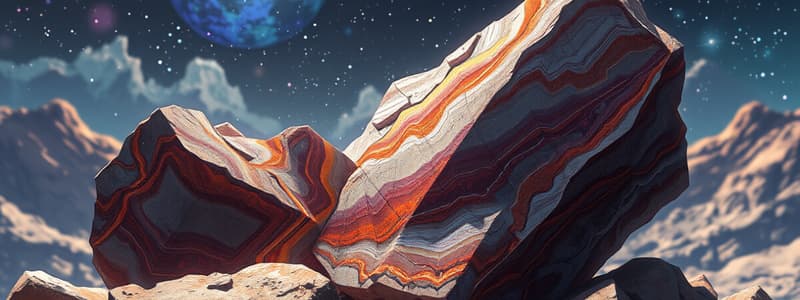Podcast
Questions and Answers
Which mineral is known to be always strongly magnetic?
Which mineral is known to be always strongly magnetic?
- Sphalerite
- Galena
- Magnetite (correct)
- Halite
What is the specific gravity of most silicate minerals?
What is the specific gravity of most silicate minerals?
- 1.0 to 2.0
- 5.0 to 8.0
- 2.6 to 3.4 (correct)
- 4.0 to 5.0
Which of the following minerals has a distinctive taste that resembles salt?
Which of the following minerals has a distinctive taste that resembles salt?
- Talc
- Halite (correct)
- Magnetite
- Barite
What characteristic can typically be used to identify the presence of striations on a mineral's cleavage surface?
What characteristic can typically be used to identify the presence of striations on a mineral's cleavage surface?
What is the specific gravity range of heavier ore minerals?
What is the specific gravity range of heavier ore minerals?
Study Notes
Magnetism
- Some minerals can be attracted to a hand magnet, allowing for a simple magnetism test.
- Magnetite is the only common mineral that is consistently strongly magnetic.
Striations
- Striations are very thin, parallel grooves found on minerals.
- These grooves appear on only one of the two cleavage sets and are best observed with a hand lens.
- Striations may not be visible on all parts of a cleavage surface; thorough examination under different light angles is necessary.
Specific Gravity
- Specific gravity is calculated by dividing the weight of the mineral by the weight of an equal volume of water, with water having a specific gravity of 1.0.
- Most silicate minerals have specific gravities ranging from 2.6 to 3.4, while ore minerals usually range from 5 to 8.
- High specific gravity can be a distinctive feature for some minerals, such as barite and galena.
Taste, Odor, Feel
- Certain minerals possess unique tastes; for example, halite tastes like salt.
- Some minerals emit distinctive odors; powdered sulfide minerals, like sphalerite, may smell like rotten eggs.
- The feel of minerals can also be notable; talc, for instance, has a slippery texture.
Studying That Suits You
Use AI to generate personalized quizzes and flashcards to suit your learning preferences.
Description
Explore the fascinating world of minerals through this quiz on magnetism and striations. Learn how to test minerals for magnetic properties and identify striations using a hand lens. This quiz will enhance your knowledge of mineral characteristics and their identification.




